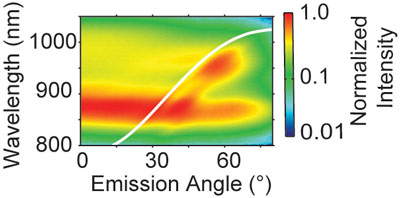| Jul 01, 2011 |
Nanowires offer opportunities for improved LEDs
|
|
(Nanowerk News) Researchers from the FOM Institute AMOLF, together with colleagues from Philips Research, Eindhoven University of Technology and Delft University of Technology, have made special nanostructures that could be used as light-emitting diodes (LEDs). These nanostructures can be used to control the direction of the emission. Controlling the direction of the light is vitally important for increasing the efficiency of LEDs. It is also a step towards a new generation of LEDs that are based on semiconducting nanowires. The results of this research will soon be published in the prestigious journal ACS Nano ("Controlling the Directional Emission of Light by Periodic Arrays of Heterostructured Semiconductor Nanowires").
|
|
Measurement of the intensity of the light emitted by the nanowires as a function of the wavelength (i.e. colour) and the angle of the light emitted. The maximum depends on the emitter, which is located in the nanowires. In this case it is at 950 nm and 55 degrees.
|
 |
| Diagram of the light intensity. Measurement of the intensity of the light emitted by the nanowires as a function of the wavelength (i.e. colour) and the angle of the light emitted. The maximum depends on the emitter, which is located in the nanowires. In this case it is at 950 nm and 55 degrees.
|
|
Nanostructures
|
|
The direction in which a LED emits light is mainly determined by the surface between the LED and the surrounding air. As light can only escape from the LED at small angles, the direction of emission is usually straight on (perpendicular to the surface). However this can be influenced by nanostructures in the surface of the LED. Inspired by these nanostructures, the researchers have developed a new technology with which the direction of the light can be changed.
|
|
Photonic crystal
|
|
The new method consists of growing partially-emitting nanowires in an ordered pattern. This pattern forms a 'photonic crystal' that sends the light in specific directions. Furthermore, the researchers have shown that the emission can be optimised by a smart positioning of the emitting part within the nanowire. This knowledge could lead to an increased efficiency of LEDs. Moreover it provides opportunities for a next generation of LEDs, based on semiconducting nanowires.
|
|
This research is part of the Industrial Partnership Programme 'Improved solid-state light sources' of the Foundation for Fundamental Research on Matter (FOM) and Philips and the FOM Programme 'NanoPhotovoltaics'. It also received support from Technology Foundation STW.
|
|
Further information
|
|
Jaime Gómez Rivas, FOM Institute AMOLF, c/o Philips Research Laboratories Eindhoven, High Tech Campus 4, 5656 AE Eindhoven, Telephone +31 (0)40 274 23 49.
|

